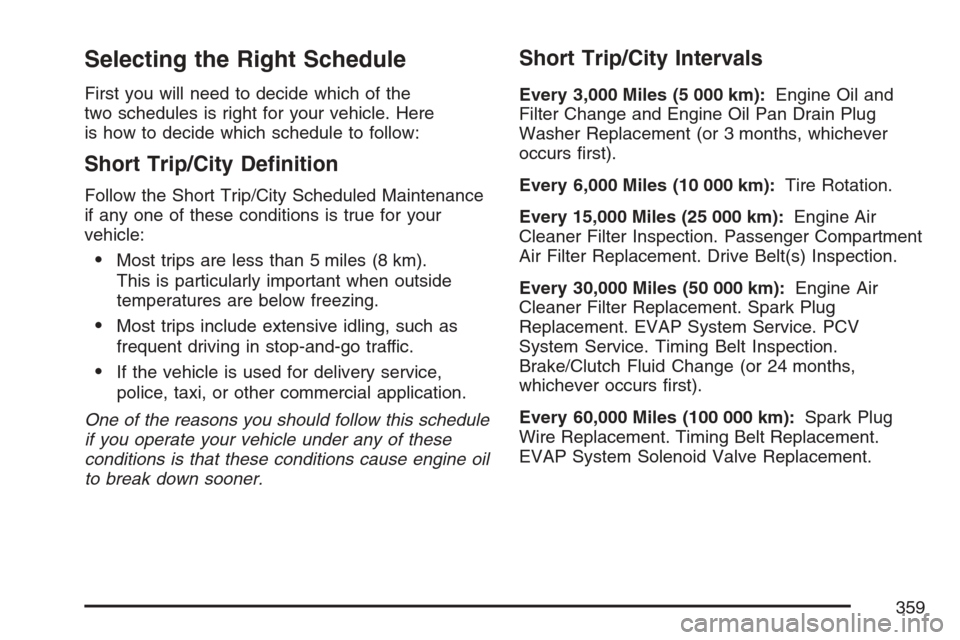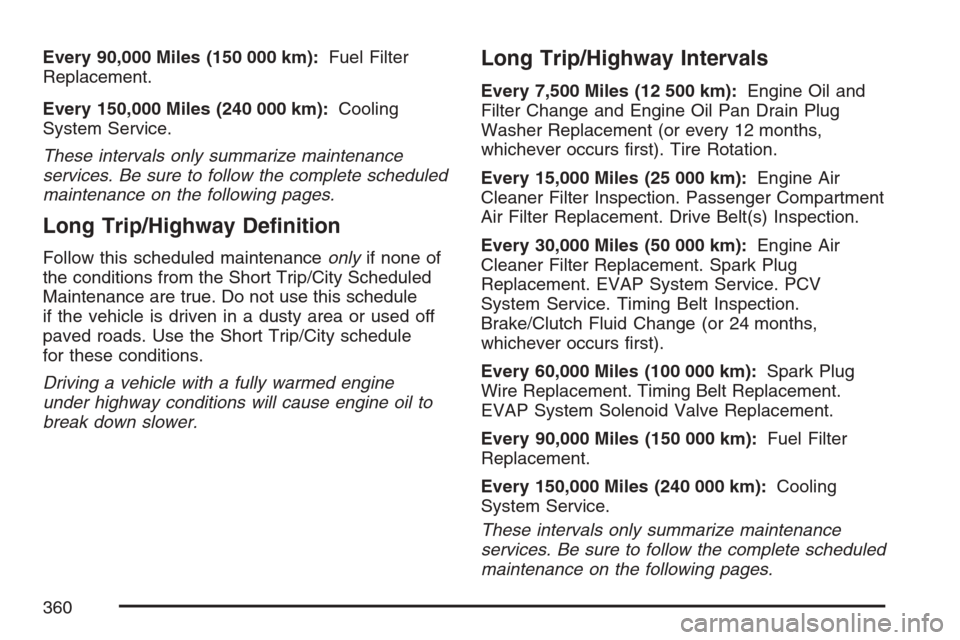2007 CHEVROLET OPTRA 5 washer fluid
[x] Cancel search: washer fluidPage 228 of 422

Here are some things you can check before a trip:
•Windshield Washer Fluid:Is the reservoir
full? Are all windows clean inside and outside?
•Wiper Blades:Are they in good shape?
•Fuel, Engine Oil, Other Fluids:Have you
checked all levels?
•Lamps:Are they all working? Are the lenses
clean?
•Tires:They are vitally important to a safe,
trouble-free trip. Is the tread good enough
for long-distance driving? Are the tires
all inflated to the recommended pressure?
•Weather Forecasts:What is the weather
outlook along your route? Should you
delay your trip a short time to avoid a major
storm system?
•Maps:Do you have up-to-date maps?
Highway Hypnosis
Is there actually such a condition as highway
hypnosis? Or is it just plain falling asleep at the
wheel? Call it highway hypnosis, lack of
awareness, or whatever.
There is something about an easy stretch of road
with the same scenery, along with the hum of the
tires on the road, the drone of the engine, and the
rush of the wind against the vehicle that can make
you sleepy. Do not let it happen to you! If it does,
your vehicle can leave the road in less than a
second, and you could crash and be injured.
What can you do about highway hypnosis?
First, be aware that it can happen.
Then here are some tips:
•Make sure your vehicle is well ventilated, with
a comfortably cool interior.
•Keep your eyes moving. Scan the road ahead
and to the sides. Check your rearview mirrors
and your instruments frequently.
•If you get sleepy, pull off the road into a rest,
service, or parking area and take a nap, get
some exercise, or both. For safety, treat
drowsiness on the highway as an emergency.
228
Page 245 of 422

Service........................................................ 248
Accessories and Modifications................... 249
California Proposition 65 Warning.............. 249
Doing Your Own Service Work.................. 250
Adding Equipment to the Outside of
Your Vehicle.......................................... 251
Fuel............................................................. 251
Gasoline Octane........................................ 251
Gasoline Specifications.............................. 251
California Fuel........................................... 252
Additives................................................... 252
Fuels in Foreign Countries........................ 253
Filling the Tank......................................... 254
Filling a Portable Fuel Container............... 256
Checking Things Under the Hood.............. 256
Hood Release........................................... 257
Engine Compartment Overview.................. 258
Engine Oil................................................. 260
Engine Air Cleaner/Filter............................ 264
Automatic Transaxle Fluid......................... 266Manual Transaxle Fluid............................. 266
Hydraulic Clutch........................................ 266
Engine Coolant.......................................... 268
Coolant Surge Tank Pressure Cap............ 271
Engine Overheating................................... 271
Cooling System......................................... 273
Power Steering Fluid ................................. 279
Windshield Washer Fluid........................... 280
Brakes...................................................... 281
Battery...................................................... 284
Jump Starting............................................ 285
Headlamp Aiming........................................ 290
Bulb Replacement....................................... 290
Halogen Bulbs........................................... 290
Headlamps................................................ 290
Front Turn Signal and Parking Lamps.......... 292
Turn Signal Lamps (Side).......................... 293
Sidemarker Lamps (Front)......................... 294
Sidemarker Lamps (Rear).......................... 295
Section 5 Service and Appearance Care
245
Page 259 of 422

A. Engine Air Cleaner/Filter. SeeEngine Air
Cleaner/Filter on page 264.
B. Engine Oil Fill Cap. See “When to Add Engine
Oil” underEngine Oil on page 260.
C. Engine Oil Dipstick. See “Checking Engine Oil”
underEngine Oil on page 260.
D. Brake Fluid/Hydraulic Clutch Fluid Reservoir.
See “Brake Fluid” underBrakes on page 281
andHydraulic Clutch on page 266.
E. Power Steering Fluid Reservoir. SeePower
Steering Fluid on page 279.F. Engine Coolant Surge Tank. SeeCooling
System on page 273.
G. Engine Compartment Fuse Block. SeeEngine
Compartment Fuse Block on page 349.
H. Windshield Washer Fluid Reservoir. See
“Adding Washer Fluid” underWindshield
Washer Fluid on page 280.
I. Battery. SeeBattery on page 284.
259
Page 280 of 422

Windshield Washer Fluid
What to Use
When you need windshield washer fluid, be sure
to read the manufacturer’s instructions before
use. If you will be operating your vehicle in an area
where the temperature may fall below freezing,
use a fluid that has sufficient protection against
freezing.
Adding Washer Fluid
Open the cap with the
washer symbol on it.
Add washer fluid until
the tank is full. See
Engine Compartment
Overview on page 258
for reservoir location.Notice:
When using concentrated washer �uid,
follow the manufacturer’s instructions
for adding water.
Do not mix water with ready-to-use washer
�uid. Water can cause the solution to
freeze and damage your washer �uid tank
and other parts of the washer system.
Also, water does not clean as well as
washer �uid.
Fill your washer �uid tank only
three-quarters full when it is very cold.
This allows for expansion if freezing
occurs, which could damage the tank if it
is completely full.
Do not use engine coolant (antifreeze) in
your windshield washer. It can damage
your washer system and paint.
280
Page 359 of 422

Selecting the Right Schedule
First you will need to decide which of the
two schedules is right for your vehicle. Here
is how to decide which schedule to follow:
Short Trip/City De�nition
Follow the Short Trip/City Scheduled Maintenance
if any one of these conditions is true for your
vehicle:
•Most trips are less than 5 miles (8 km).
This is particularly important when outside
temperatures are below freezing.
•Most trips include extensive idling, such as
frequent driving in stop-and-go traffic.
•If the vehicle is used for delivery service,
police, taxi, or other commercial application.
One of the reasons you should follow this schedule
if you operate your vehicle under any of these
conditions is that these conditions cause engine oil
to break down sooner.
Short Trip/City Intervals
Every 3,000 Miles (5 000 km):Engine Oil and
Filter Change and Engine Oil Pan Drain Plug
Washer Replacement (or 3 months, whichever
occurs first).
Every 6,000 Miles (10 000 km):Tire Rotation.
Every 15,000 Miles (25 000 km):Engine Air
Cleaner Filter Inspection. Passenger Compartment
Air Filter Replacement. Drive Belt(s) Inspection.
Every 30,000 Miles (50 000 km):Engine Air
Cleaner Filter Replacement. Spark Plug
Replacement. EVAP System Service. PCV
System Service. Timing Belt Inspection.
Brake/Clutch Fluid Change (or 24 months,
whichever occurs first).
Every 60,000 Miles (100 000 km):Spark Plug
Wire Replacement. Timing Belt Replacement.
EVAP System Solenoid Valve Replacement.
359
Page 360 of 422

Every 90,000 Miles (150 000 km):Fuel Filter
Replacement.
Every 150,000 Miles (240 000 km):Cooling
System Service.
These intervals only summarize maintenance
services. Be sure to follow the complete scheduled
maintenance on the following pages.
Long Trip/Highway De�nition
Follow this scheduled maintenanceonlyif none of
the conditions from the Short Trip/City Scheduled
Maintenance are true. Do not use this schedule
if the vehicle is driven in a dusty area or used off
paved roads. Use the Short Trip/City schedule
for these conditions.
Driving a vehicle with a fully warmed engine
under highway conditions will cause engine oil to
break down slower.
Long Trip/Highway Intervals
Every 7,500 Miles (12 500 km):Engine Oil and
Filter Change and Engine Oil Pan Drain Plug
Washer Replacement (or every 12 months,
whichever occurs first). Tire Rotation.
Every 15,000 Miles (25 000 km):Engine Air
Cleaner Filter Inspection. Passenger Compartment
Air Filter Replacement. Drive Belt(s) Inspection.
Every 30,000 Miles (50 000 km):Engine Air
Cleaner Filter Replacement. Spark Plug
Replacement. EVAP System Service. PCV
System Service. Timing Belt Inspection.
Brake/Clutch Fluid Change (or 24 months,
whichever occurs first).
Every 60,000 Miles (100 000 km):Spark Plug
Wire Replacement. Timing Belt Replacement.
EVAP System Solenoid Valve Replacement.
Every 90,000 Miles (150 000 km):Fuel Filter
Replacement.
Every 150,000 Miles (240 000 km):Cooling
System Service.
These intervals only summarize maintenance
services. Be sure to follow the complete scheduled
maintenance on the following pages.
360
Page 374 of 422

Part B: Owner Checks and Services
Listed in this part are owner checks and services
which should be performed at the intervals
specified to help ensure the safety, dependability
and emission control performance of your
vehicle.
Be sure any necessary repairs are completed at
once. Whenever any fluids or lubricants are added
to your vehicle, make sure they are the proper
ones, as shown in Part D.
At Each Fuel Fill
It is important for you or a service station attendant
to perform these underhood checks at each fuel fill.
Engine Oil Level Check
Check the engine oil level and add the proper oil
if necessary. SeeEngine Oil on page 260for
further details.
Engine Coolant Level Check
Check the engine coolant level and add the proper
coolant mixture if necessary. SeeEngine Coolant
on page 268for further details.
Windshield Washer Fluid Level Check
Check the windshield washer fluid level in the
windshield washer fluid reservoir and add
the proper fluid if necessary. SeeWindshield
Washer Fluid on page 280for further details.
At Least Once a Month
Tire In�ation Check
Visually inspect the tires and make sure the tires
are inflated to the correct pressures. Do not
forget to check the spare tire. SeeInflation - Tire
Pressure on page 311.
374
Page 382 of 422

Part D: Recommended Fluids and
Lubricants
Fluids and lubricants identified below by name,
part number, or specification can be obtained from
your dealer.
Usage Fluid/Lubricant
Engine OilEngine oil which meets GM
Standard GM6094M and displays
the American Petroleum Institute
Certified for Gasoline Engines
starburst symbol. GM Goodwrench
®
oil meets all the requirements for
your vehicle. To determine the
proper viscosity for your vehicle’s
engine, seeEngine Oil on page 260.
Engine Coolant50/50 mixture of clean, drinkable
water and use only DEX-COOL
®
Coolant. SeeEngine Coolant on
page 268.
Usage Fluid/Lubricant
Hydraulic Brake
SystemDelco
®Supreme 11 Brake Fluid or
equivalent DOT-3 brake fluid.
Windshield
Washer SolventGM Optikleen
®Washer Solvent.
Power Steering
SystemDEXRON
®-VI Automatic
Transmission Fluid.
Automatic
TransaxleAutomatic Transaxle Fluid ESSO LT
71141 or TOTAL ATF H50235
(GM Part No. in Canada 89021903).
Manual
TransaxleManual Transmission Fluid
(GM Part No. U.S. 89021806,
in Canada 89021807).
Key Lock
CylindersMulti-Purpose Lubricant, Superlube
(GM Part No. U.S. 12346241,
in Canada 10953474).
Manual
Transaxle Shift
LinkageChassis Lubricant
(GM Part No. U.S. 12377985,
in Canada 88901242) or lubricant
meeting requirements of NLGI #2,
Category LB or GC-LB.
382